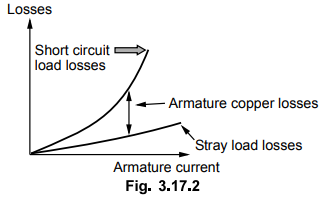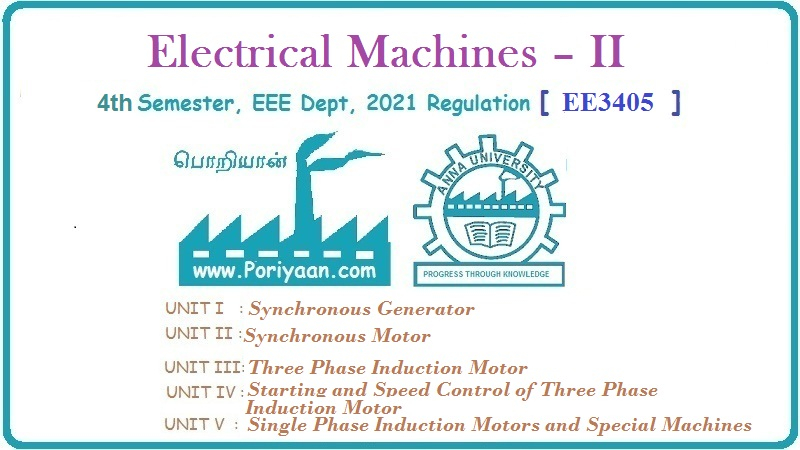Electrical Machines II: UNIT I: c. Synchronization and Parallel Operation of Alternators
Efficiency of Synchronous Machine
The stray load losses and direct load losses together called short circuit load losses.
Efficiency of Synchronous Machine
The
different possible losses in a synchronous machine are,
i)
No load rotational losses which are further divided as (a) friction and windage
losses and (b) open-circuit core losses
ii)
Field winding copper losses (l2fRf)
iii)
Armature winding copper losses (l2aRa) called
direct load losses
iv)
Stray load losses
The
stray load losses and direct load losses together called short circuit load
losses.
The
open circuit core losses include eddy current and hysteresis losses which
depend on the square of the open circuit voltage. This is shown in the Fig.
3.17.1 (a).

These
losses exist as long as field winding is
excited. The friction and windage losses
are constant with respect to field
current. These losses exist though
the field winding is not energised and
machine is running on no load. Thus
the graph of rotational losses against field current has an intercept on
vertical axis as shown in the Fig. 3.17.1 (b).

Short
circuit load loss = [Stray load losses] + [Armature copper losses]
The
variation of stray load losses against armature current is shown in the Fig.
3.17.2.

The
stray load losses include core loss due to armature leakage flux and armature
ohmic loss due to skin effect. The armature copper loss component is calculated
by considering hot value of d.c. armature resistance generally at a temperature
of 75°C.
The
effective value of armature resistance is obtained as,
Ra
(effective) = Stray load losses / (Iasc)2
where
Iasc = Short circuit armature current. Once calculated at the rated
current, Ra (effective) is constant at all load conditions.
The
power flow diagram for three phase alternator is shown in the Fig. 3.17.3.

Once
all the losses are known then the alternator efficiency can be obtained as,
% ƞ = output / output + Losses × 100
1. Maximum Efficiency
For
a synchronous machine, Variable losses = Armature copper losses. Constant
losses = Field copper losses + No load rotational losses
Similar
to d.c. machine, the maximum efficiency occurs when variable losses are equal
to the constant losses.
Derivation
:

where
Ia = Iam = Amature current at whcih maximum ƞ occurs.
Example
3.17.1 A 30 MVA, 15 kV, 60 Hz ac generator has a
synchronous reactance of 1.2 pu and a resistance of 0.02 pu. Calculate. (1) the
base voltage, base power and base impedance of the generator, (2) the actual
value of the synchronous reactance, (3) the actual winding resistance, per
phase (4) the total full-load copper losses. AU : May-17, Marks 8
Solution :
Solution
:

2)
XS = 1.2 pu
XS
= XS (pu) × ZB = 1.2 × 7.5 = 92 Ω
3)
Ra = 0.02 pu
Ra
= Ra (pu) × ZB = 0.02 × 7.5 = 0.15 Ω
4)
On full load, per unit value of current is unity i.e. 1 = 1 pu.
Per
unit copper loss = I2 × Ra (pu) = 0.02 pu (per ph)
Total
actual copper loss = 3 × 0.02 pu × SB
=
3 × 0.02 × 10 × 106 = 600 kW
Examples for Practice
Example
3.17.2 A 500 kVA, 11 kV, 3ϕ star-connected, alternators
has the following data :
Friction
and windage loss = 1500 W
Open-circuit
core loss = 2500 W
Effective
armature resistance/phase = 4Ω
Field
copper loss = 1000 w
Find
the following parts in regarding with above sychronous alternators :
i)
Alternator efficiency of half-full load and at 0.85 power factor lagging.
ii)
Maximum efficiency of the alternator.
[Ans.:
i) %ƞ = 96.78 %, ii) %^m = 97.06 %]
Example
3.17.3 A 3 ϕ, hydro-electric synchronous generator is
read to be 110 MW, 0.8 pf. lagging, 6 kV, Y-connected, 50 Hz, 100 rpm.
Determine the following
i)
The number of poles, ii) The kVA rating iii) The prime-mover rating if the
full-load generator efficiency is 97.1 % (level out field loss)
[Ans.:
i) 60 poles ii) 137.5 x103 kVA iii) 113.285 MW]
Review Question
1. Write a note on losses in a synchronous machine.
Electrical Machines II: UNIT I: c. Synchronization and Parallel Operation of Alternators : Tag: Engineering Electrical Machines - II : - Efficiency of Synchronous Machine
Related Topics
Related Subjects
Electrical Machines II
EE3405 Machine 2 EM 2 4th Semester EEE Dept | 2021 Regulation | 4th Semester EEE Dept 2021 Regulation
